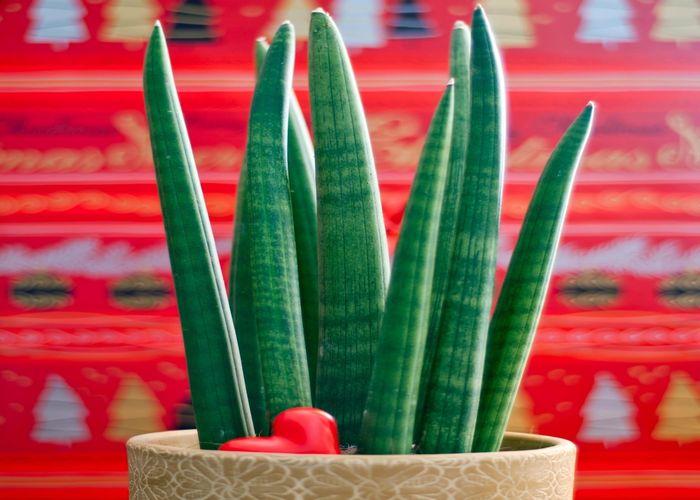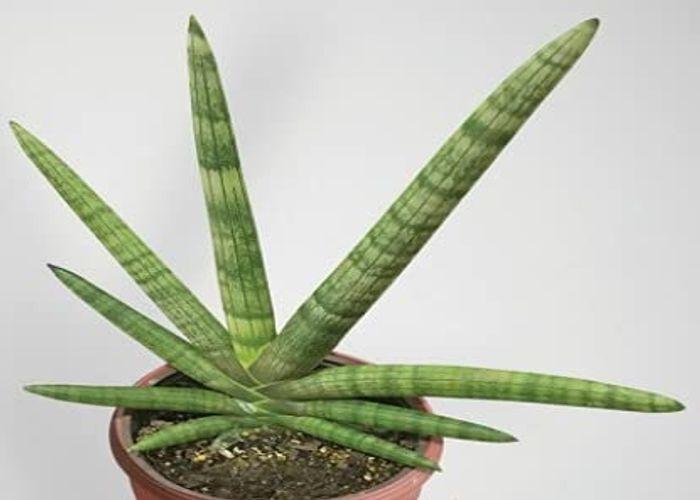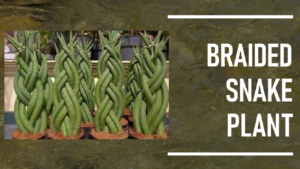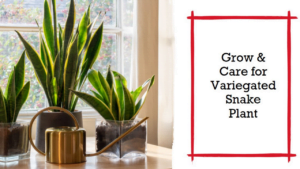Do you want a plant that does not need much care and has impressive spear-like leaves? Then you might want to consider Sansevieria cylindrica.
The evergreen perennial Sansevieria cylindrica is also known as African Spear and has distinct, round leaves that grow from a basal rosette is what makes these succulents interesting. It is an extremely resilient houseplant that can refresh the air inside your home, providing a friend in need. In addition, since it is capable of keeping the negative energies away, it is very useful to those who are interested in Feng Shui culture.
So, today in this article, you can learn more about this amazing-looking plant by checking out our guide to growing and caring for sansevieria cylindrica and their varieties below!
Fun fact: Sansevieria cylindrica has its unique type of photosynthesis at night as it releases oxygen even during nighttime!
First, let us know about this plant, and why it is so popular and important for you to bring home!
About Sansevieria cylindrica!
| Botanical name | Sansevieria cylindrica |
| Common name | African spear plant, cylindrical snake plant, spear sansevieria |
| Plant type | Succulent |
| Mature size | 4–6 ft. tall, 1–2 ft. wide |
| Light | Full, partial |
| Water | To keep the soil moist |
| Fertilizer | Succulent fertilizer |
| Soil type | Sandy, well-drained |
| Soil pH | Neutral |
| Bloom time | Sporadic |
| Flower color | White |
| Native area | Africa |
| Toxicity | Toxic to pets and humans |
Do you know the varieties of snake plants that exist in nature? Let’s know them below!
Cylindrical snake plant varieties
Sansevieria cylindrica plants come in several varieties, but I will discuss only a few of them below:
1. Sansevieria cylindrica ‘Spaghetti’

In this cultivar, the leaves are especially thin.
2. Sansevieria cylindrica ‘Skyline’

Compared to other cultivars, this one has large, erect leaves.
3. Sansevieria cylindrica ‘Patula’

Unlike most other varieties, this plant’s leaves grow outward and bend down more.
Since you now know the varieties of snake plants, let us explore how to grow and care for them!
How to grow a Sansevieria cylindrica plant?
Cuttings, underground rhizomes, and division are all effective methods of growing Sansevieria cylindrica.
Follow the below steps to grow a healthy cylindrica plant.
- For division, wait until the underground rhizome leaves are at least 6 inches long.
- Using a sharp knife, remove the basal rosette of leaves.
- Get rid of the old soil and plant directly in your new pot.
- To ensure proper growth, use single leaf cuttings between 3 – 4 inches in diameter and plant them upright.
- Push the cuttings into the potting mix and place them in a bright area to grow.
- Water the soil regularly and wait for the plant to take root. Be patient, this process could take some time.
How to care for a Sansevieria cylindrica plant?
1. Light requirements for Sansevieria cylindrica

Low light conditions are not a problem for these plants, but they prefer some full sun, filtered with bright light. For outdoors, they will appreciate the morning sun but should be protected from the direct hot afternoon sun. For indoors, they prefer a window facing north.
Also, a high level of light can cause the leaves to yellow around the edges, and a low level of light can result in slow growth.
2. Soil requirements for Sansevieria cylindrica

As with most succulents, these plants prefer sandy soil that drains well. Hence, it is ideal to use a potting mix made specifically for succulents.
3. Water requirements for Sansevieria cylindrica
Sansevieria cylindrica can survive long periods of drought. When the roots are left in wet soil for too long, they will rot.
If the soil becomes dry between waterings, then water deeply. It is generally sufficient to water every week or every other week.
However, if you are growing your plant in a container, make sure to drain any excess water that passes through the drainage holes. In the winter, water less frequently than you did in the summer. It is fine to water once a month.
4. Temperature and Humidity requirements for Sansevieria cylindrica

Normally, succulents grow in hot, dry climates, so cold temperatures can harm or kill them. Make sure they are kept at a temperature above 50 F. In addition, they need to be protected from cool drafts, including those generated by air conditioners. Additionally, as long as the soil isn’t saturated, humidity isn’t a problem.
5. Fertilizer requirements for Sansevieria cylindrica
In lean soil, African spear plants can survive without fertilizer. From spring to fall, feed them a succulent fertilizer diluted to half strength. Also, there is no need to fertilize in the winter.
6. Pruning requirements for Sansevieria cylindrica
In general, you won’t need to prune this plant, but you can remove yellowed or discolored leaves for aesthetic reasons. By simply cutting them at their base with sterilized pruning shears, you will be able to remove them. Alternatively, you can start new plants from plant offshoots.
Moreover, before separating these baby plants from the main plant, wait until they are at least 6 inches high.
7. Repotting requirements for Sansevieria cylindrica
Once the roots start growing out of the pot, it’s unlikely you will have to repot your plant more than every few years if it’s in a container. So, move it just one container size up, as its roots will still like being a little cramped.
To anchor the weight of the leaves, you should use a heavy pot that is shallow and wide. Otherwise, your plant might easily tip over. Make sure the pot has plenty of drainage holes as well.
8. Pests requirements for Sansevieria cylindrica
Aphids, vine weevils, and mealybugs are the most common sansevieria cylindrica invaders. Pest infestations are less likely to affect spear plants that grow indoors in a controlled environment. Hence, make sure your plant is regularly inspected and insects are removed.
9. Disease requirements for Sansevieria cylindrica
Generally, African snake spears are pest- and disease-resistant; however, overwatering can cause their roots to rot and their leaves to discolor. Keep your plant healthy by checking regularly for signs of pests or diseases.
Do you know the benefits of these snake plants? Let’s check them below!
Benefits of the Sansevieria cylindrica plant!
Snake plants have multiple benefits in addition to their stunning appearance. Let’s check them out below!
- As a potted plant, this plant is a gorgeous ornamental addition to any house or garden.
- In a pedestal display, the plant enhances contemporary designs very well.
- It cleans the air inside your home.
- Eliminates toxic pollutants.
- It may boost mental health.
- It is easy to take care of.
- As per feng shui, it may enhance a room’s “energy”
- Treats minor aches and pains.
FAQs
Q1. How do you take care of a snake plant, Cylindrica?
Ans. It requires little water since it is drought-tolerant. During Cylindrica’s growth, water thoroughly and let the potting mix almost dry out before rewatering. After the plant has become established, you can wait even longer before watering it. A once-a-week interval should be sufficient.
Q2. How often should you water Sansevieria cylindrica?
Ans. Water it about twice a week during the growing season. Make sure to water the soil instead of the leaves. Whenever the stalks’ base becomes yellow or swollen, you are overwatered. Make sure the soil is fully moist, but that it drains completely before you water it again.
Q3. How tall does Sansevieria cylindrica grow?
Ans. It grows to a height of 2-3 feet indoors but could grow larger outdoors in warm weather (70-90 degrees Fahrenheit) with well-drained soil. Sansevieria plants thrive in warmer temperatures and areas with lots of sunlight.
Q4. How do you prune a Sansevieria cylindrica?
Ans. It is not necessary to prune Sansevieria cylindrica in general. If desired, you can trim the leaves of a Sansevieria cylindrica succulent plant to shape it or add texture to your pot. Also, cut off leaves that have grown too long or are dried out.
Conclusion
The Sansevieria Cylindrica succulent is a popular houseplant. When the proper environmental conditions are met, these plants can thrive indoors or outdoors. Even if you are occasionally careless or forgetful about your Sansevieria plants, they will thrive.
In addition, when the Sansevieria plant feels loved and happy, it will reward you with a mesmerizing scent.
Do you have a variety of Sansevieria cylindrica at home? Of course, I would love to hear from you! Please comment down below if you have something interesting to share with us. Also, don’t forget to share this article with your friends and family and also on social media. Please do this as a favor as it will help my article to reach like-minded people!







